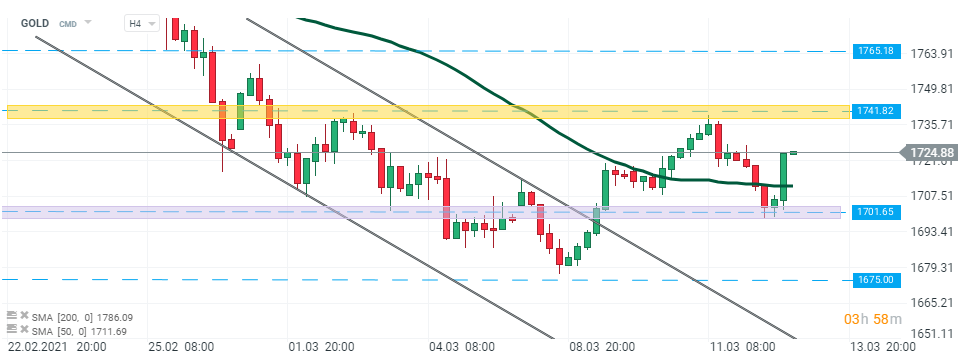- US 10-year yield reached new 1-year high
- President Biden signed $1.9 trillion COVID-19 relief bill
- Dow at new all-time high, Nasdaq under pressure
European indices finished today's session mixed, as investors remain concerned about rising bond yields and increasing number of COVID-19 cases in Germany and in Italy. Robert Koch Institute for infectious diseases (RKI) warned that a third wave of coronavirus infections had begun. Meanwhile another lockdown in Italy will start on March 15 and will include 8 regions, including the area around Rome. On the corporate front, Daimler stock fell 1.9% after Renault sold its stake in the German company at a discount; while BMW shares lost 1.3% after the company announced that its operating profit for 2020 fell due to the pandemic. DAX 30 fell 0.5%, CAC40 rose 0.21% and FTSE100 finished 0.4% higher.
US indices are trading mixed as well. Dow Jones again reached new all-time high while S&P500 fell 0.12% and Nasdaq dropped more than 1% as the yield on the benchmark 10-Year Treasury note rose to 1.63%, the highest level this year. It turns out that the positive events in the form of the ECB's announcements on a faster pace of asset purchases and President Biden's signing the $1.9 trillion stimulus bill did not have much effect on the market. Higher yields raise concerns about the stability of the current upward trend in the stock markets. Theoretically, thanks to young investors who plan to spend up to half of the $ 1,400 checks on investments, nearly $ 150 billion may move towards the stock exchange. On the other hand, markets mostly focus on inflation. Checks for citizens will stimulate consumption, and that in turn will stimulate prices. Rising prices may lead to higher bond yields, which in turn are negative news, potentially for the entire financial system. On the other hand, financial companies tend to benefit from higher bond yields. The technology sector is again recording the biggest declines. Interestingly, the sell-off is mainly caused by China, which is aiming to increase control of this sector due to its importance for the entire economy.
WTI crude fell 0.3% and is trading around $65.80 a barrel, while Brent is trading 0.4% lower around $69.40 a barrel. Yesterday, OPEC lowered its crude demand forecast for Q1 by 180,000 bpd and Q2 by 310,000 bpd but said that global demand recovery would occur in H2 2021 and raised its estimates for Q3 by 400,000 bpd and Q4 by 970,000 bpd. Elsewhere gold rose to $ 1,722.00 / oz, after touching $1700/oz level earlier in the session while silver is trading 0.85 % lower around $ 25.80 / oz.
 Gold launched today’s session lower, however buyers failed to break below the strong support at $1700,00 and price managed to erase part of the recent losses. Precious metal also broke above 50 SMA ( green line) and if the current sentiment prevails, upward move could be extended to the resistance at $1741.00. However if sellers will manage to regain control and break below the aforementioned $1700.00 level, then next support at $1675 could be at risk. Source: xStation5
Gold launched today’s session lower, however buyers failed to break below the strong support at $1700,00 and price managed to erase part of the recent losses. Precious metal also broke above 50 SMA ( green line) and if the current sentiment prevails, upward move could be extended to the resistance at $1741.00. However if sellers will manage to regain control and break below the aforementioned $1700.00 level, then next support at $1675 could be at risk. Source: xStation5
Daily Summary: CPI down, Markets Up
3 markets to watch next week (24.10.2024)
US OPEN: Macroeconomic data sends markets to new heights
BREAKING: US PMI above expectations! 📈🔥EURUSD declines!


